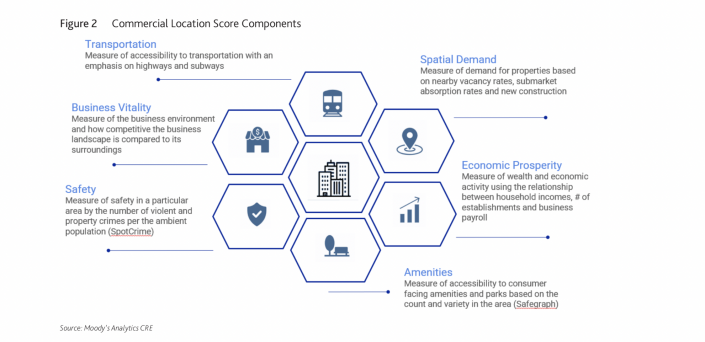
Moody’s Analytics: Thomas LaSalvia, Ricardo Rosas, Lu Chen
As the COVID-19 pandemic fades into the background, scientists are using the housing data generated over the last couple of years to paint a more accurate picture of how and where Americans want to live. In The Real Deal’s second exclusive conversation with the researchers at Moody’s Analytics, we spoke with Senior Economists Thomas LaSalvia and Lu Chen and Data Analyst Ricardo Rosas about their new paper “Loyalty to An Urban Lifestyle,” in which they not only tracked pandemic-era urban migration patterns but also developed a new method of defining Commercial Business Districts that will help future researchers more accurately capture the reality of multifamily housing in American cities. Using this new metric, LaSalvia, Chen, and Rosas were able to measure, for the first time, just how dedicated to urban living a new segment of Americans has become, and how that dedication was ultimately unshaken by the pandemic.
Defining Central Business Districts
“Since the onset of the pandemic, we have all heard lots of voices from different angles talking about how people are leaving the big metros, or at a minimum, hollowing out the center of these metros,” said Chen, whose job it is to ask, “but is that really true?” So Chen, LaSalvia, and Data Analyst Ricardo Rosas delved into the numbers. The first big problem they encountered was how exactly to define “big metros”, and specifically the residential center of those metros, in a way that captured the nuances of where multifamily developments were actually being built and where Americans were choosing to live. The United States’ unique urban history helped the team shape this definition: suburbanization during the 20th Century created a vacuum in America’s urban centers that has only been recently filled with what the researchers describe as “high-quality housing, improved
sanitation, robust infrastructure, and a broad option for entertainment and leisure,” resulting in a new type of neighborhood that centers proximity to experiences over square footage.

This pattern created not only a new type of development area but also a new group of Americans, who LaSalvia calls “urban lovers, or individuals and households that desire direct access to amenities that often only occur at high levels of density.” These urban lovers are attracted to areas with high Commercial Location Scores [FIGURE 2], specifically those that score highest in business vitality, economic prosperity, amenities, and transportation. Neighborhoods with multifamily housing and high scores in these areas are delimited as Central Business Districts, or simply city centers, a new definition that describes a phenomenon that’s been building for a couple of decades. The researchers then used the Central Business District measurement to figure out whether the pandemic really affected where Americans wanted to live.
The Future of Cities is Bright
Once they developed a method of delimiting these Central Business Districts, the researchers had the tools to figure out if Americans really did leave cities in big numbers due to the pandemic. What they found supports the conventional wisdom while revealing a larger underlying shift in how some Americans want to live. At the beginning of the pandemic, many of the benefits that drew urban lovers to their city center homes went away, including in-person shopping, dine-in restaurants, and access to cultural institutions like museums. Similarly, remote work negated the benefit of a quick commute to the office via public transit. Meanwhile, according to the paper, “amenities outside cities were less impacted by lockdown restriction, and therefore retained their marginal benefit much better than their Central Business District counterparts,” which caused a measurable exodus from these city centers during Q2 2020 to Q1 2021 and a corresponding decrease in rent growth and increase in vacancies in city centers during that time.
However, this initial shock did not last, and as vaccines became widely available, the urban housing market bounced back with such force that it ultimately jumped past pre-pandemic occupancy levels. “The basic economic concept is elasticity,” said Chen when describing this phenomenon. “During the downturn, when the cost was not justifiable, people just left the city centers. But, when it rebounded, it rebounded really quickly and strong.” By the end of 2021, apartment vacancies in city centers were lower than they were at the end of 2019, just before the pandemic began, and the trend shows no sign of slowing down.
We’ve progressed as a society in the US and embraced urban life in the last two decades more than ever before, said LaSalvia. Combined with delayed child rearing, preference shifts have created a whole set of people that appreciate the urban lifestyle aside from its proximity to work; an important phenomenon given the likely permanent uptick in remote work. In the end, it’s likely that the COVID-19 pandemic will represent a minor blip in a much larger story about one group of Americans falling in love with urban living.
New Ways to Measure Reality
None of these conclusions should be particularly surprising for people who have been paying attention to the multifamily market for the last decade. The real value of this Moody’s study is methodological. Chen, LaSalvia, and Rosas pioneered a new method of delimiting an emergent type of neighborhood, creating a dataset that helps describe how Americans lived before and during the COVID-19 pandemic. Best of all, the method is future-proofed, giving researchers the tools they need to adjust the boundaries of a city center as it changes over time. “The dataset that we employed to be able to delineate the Central Business District includes a commercial location score, which we tend to update every single month,” said Chen. This formula allows researchers to capture “the latest and best” information no matter what time period they’re describing.
“We went out of our way to try to quantitatively define Central Business District in the multifamily setting,” said LaSalvia. “This approach is fairly unique across both industry and academic research, and will better allow us to track changes in residential preference.” The result is a study that gives future researchers a new tool to measure the ebbs and flows of urban life in America while providing nuance to the evolving story of residential choice. Yes, many Americans moved out of large urban centers during the height of the COVID-19 pandemic, but emerging data suggest that these same centers are far from extinct. Lifestyle has become increasingly important to residential choice, and for many, the pull of urban life is too strong to dismiss.
Click here to download Loyalty to An Urban Lifestyle


